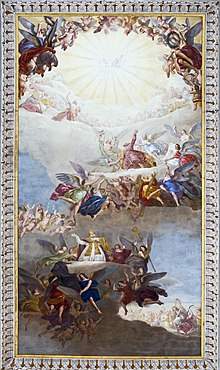San Luca (Venice)
San Luca is a parish church in the Sestiere San Marco on the Rio of the same name in Venice , which dates back to the 11th century, but was essentially built in the second half of the 16th century and at the beginning of the 17th century, but fundamentally in the 19th century was rebuilt. Only the belfry from the late Middle Ages remained . The church is consecrated to the Evangelist Luke .
history
According to Flaminius Corner, the church of San Luca Evangelista was built by the Dandolo and Pizzamano families before 1072. A three-aisled, Veneto-Byzantine building was created. In 1105 the campanile (bell tower) was damaged by fire. In 1197 there was a collegio capitulare , like a document from Pope Innocent III. emerges. In the 13th and 14th centuries, the building has been restored, according to tradition, the church was many relics that the crusade of 1204 in Constantinople Opel had been stolen, donated. By Fantino Dandolo , apostolic prothonotary and later Bishop of Padua , the church was struck several buildings in the neighborhood. In the middle of the 16th century the church was largely rebuilt, only to be consecrated in 1617.
The 24-year-old Lorenzo da Ponte , who later became Mozart's librettist , was a priest in San Luca in the 1770s. He lived nearby and met the married Anzolletta Bellaudi, who became his lover. She was accused of caressing her lovers even in churches, and Da Ponte, with whom she had two children, was also tried for his dissolute life. The background to the accusing Council of Ten was likely its heretical views. Da Ponte was banished from Venice for 15 years and fled the city.
During the Napoleonic reforms from 1807 to 1810, numerous communities were dissolved. San Luca remained, however, with the churches of the dissolved neighboring parishes of San Benedetto (San Benetto) and San Paterniano being added to the community. Later on, San Luca had to cede part of the municipality to the municipality of San Salvador . From the point of view of the archival organization in the Archivio storico del Patriarcato di Venezia , this meant that the Parrocchia di San Paternian di Venezia , then the Scuola del Santissimo Sacramento and the Devozione di Sant'Anna , belonged to the archives of the Parrocchia di San Luca di Venezia were added, as well as those of the Parrocchia di San Benetto , but also the holdings of the local Scuola del Santissimo Sacramento and the Scuola della Beata Vergine .
In 1827 part of the facade collapsed. The reconstruction was carried out by Sebastiano Santi in 1832. In 1881 another radical renovation was carried out, which practically only left the bell tower from 1457. This was reinforced by porters in 1966.
description

The facade of the single-nave church looks out onto the adjoining Fondamenta. Side altars and a chapel at the apse structure the interior. The ceiling was decorated with a fresco by Sebastiano Santi , which shows the main saint, the evangelist Luke, the saints Paternian and Benedict .
In the choir , above the altar set up in 1581, there is a Pala by Paolo Veronese ( La Vergine in Gloria appare a San Luca in atto di scrivere il Vangelo ).
In the right side chapel is La Vergine in gloria e santi by Palma il Giovane , which hung up in the church of the monastery of San Bernardo on Murano . Lorenzo Giustiniani, Primo Patriarca di Venezia che avvicina i malati e distribuisce l'elemosina by Carlo Loth , who was buried in the church, was created for the left side altar next to the main portal . Even Lodovico Dolce found his tomb there, but it is not received, nor that of Pietro Aretino .
literature
Web links
- Chiesa di San Luca , Venezia unica
- San Luca , The Churches of Venice
Remarks
- ↑ Flaminius Corner: Ecclesiae Venetae antiquis documentis nunc etiam primus editis illustratae ac in decades distributae. Venice 1749, vol. XII, p. 252ff. and Ders .: Notes storiche delle chiese e dei monasteri di Venezia e di Torcello , Padua 1758 (reprint Bologna 1990), p. 220 ( digital copy ).
- ↑ Lorenzo da Ponte. Priest, womanizer, professor - and Mozart's librettist.
- ↑ gli archivi storici della Chiesa veneziana , website of the Archivio storico del Patriarcato di Venezia .
- ^ Emmanuele Antonio Cicogna : Delle Inscrizioni Veneziane , 6 volumes, Venice 1824-1853, reprint Bologna 1969-1983, vol. 3, Giuseppe Picotti, Venice 1830, p. 305.
- ^ Anne Neuschäfer: Lodovico Dolce as a dramatic author in Venice in the 16th century. Vittorio Klostermann, 2004, p. 4.
Coordinates: 45 ° 26 ′ 9 ″ N , 12 ° 20 ′ 2 ″ E

